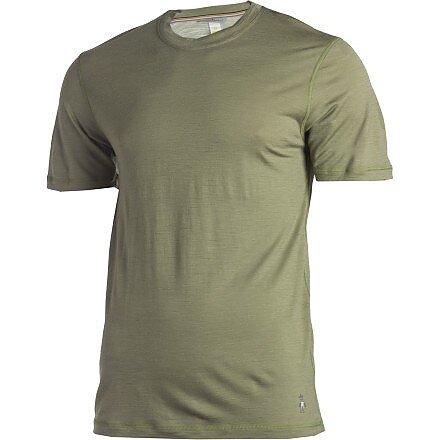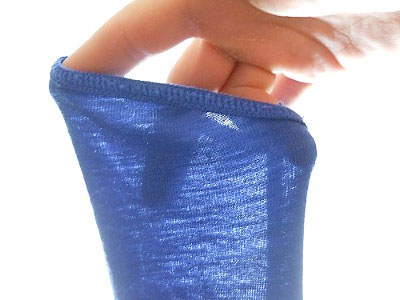Smartwool Microweight Tee

This microweight short-sleeve tee, made from SmartWool's NTS (next to skin) 150 g/sq m merino wool, can be used for days without building a noticeable smell, making it ideal for longer backpacking trips. It excels in warmer temperatures and more active pursuits like hiking and running.
SmartWool also makes lightweight (195 g/sq m) NTS baselayers, with a slightly heavier weight, and midweight (250 g/sq m) NTS baselayers for cool to cold-weather conditions, or less active pursuits. (See also my reviews of the Microweight Crew, Microweight Bottom, and Midweight Funnel Zip.)
Pros
- Bio-mapping construction puts lighter-weight fabric in high-sweat and high-movement areas, and heavier fabric where more insulation or support is desired.
- Athletic cut keeps fabric close to skin, where it can remove the most moisture.
- Wool's natural odor prevention means less funk when compared to synthetics.
Cons:
-
Garments started to pill by end of testing period.
Best For:
SmartWool's microweight baselayers are thin and light and excel in warmer temperatures and during more active pursuits, such as long-distance backpacking, hiking, or running.
The microweight garments, applicable to a wide range of conditions, are best for users who appreciate a close-fitting, thin baselayer, and who want their baselayers to wick sweat, but prefer to leave the insulation to insulating layers.
Fabric & Fit
The Microweight Tee fits well in the arms, but with a bit looser torso to provide mobility.
It has great stitching all around, without any loose threads. Raglan sleeves—where the seams connecting the sleeve to the torso are not placed on top of the shoulder—mean less chafing when worn with a pack.
The shirt appears “cut in the round,” where the panels are sewn to contour the body’s curves more truly than traditional construction might, as well as to minimize seams under arms.
This tailored construction also creates a stable microclimate against the skin. Close-fitting garments trap a micro-layer of air against the skin, allowing the body to regulate its temperature more efficiently. When it is cold out, these tiny air pockets work to hold in warm air; when it’s warm, these pockets help circulate air, keeping the skin cool. This garment excelled in that regard.
The microweight (150 g/sq m) merino wool SmartWool uses is well suited to undergarments, more stretchy and supple than synthetic materials, with an excellent drape I don't find with synthetics. The fabric colors are bold and bright. The Microweight Tee was a brilliant orange hue.

A close-up of the Smartwool baselayer fibers.
Wicking Ability
I’m always carrying a pack weighing at least 20 pounds, and my patrols as a Wilderness Ranger for the Bureau of Land Management in Colorado often involve intermittent periods of intense off-trail scrambling followed by leisurely on-trail walking.
The usual weather is 70-100°F, sunny, with little humidity. We get the occasional mid-afternoon Rocky Mountain rainstorm, and it can snow at any time in the highlands, so any baselayer I wear has to be able to capture, then disperse moisture very effectively. In this respect, this top performs admirably.
The SmartWool microweight garments use a very lightweight, nearly see-through, 150 g/sq m merino.
Because of its light fabrics and open weave, this shirt is very permeable to air. I recall multiple occasions when wearing just the top, my shirt was dry in minutes after running.
Worn under other layers, this same open weave helps to move moisture to outer layers, where it can further disperse.
I often wear the Microweight Tee under a lightweight softshell cycling jacket, and the shirt does a fine job transferring moisture to the inner nap of the jacket, keeping me dry even during 20+ mile road rides.
Though this fabric is probably as heavy as a traditional silkweight fabric, here it is sewn in very small, parallel channels that raise the fabric off the skin. It increases airflow and moisture dispersion as a function of the increased surface area created by their wavy pattern. The weave is visibly looser than the other parts of the garments, if only because the weave of the fabric is responsible for the channels.
Odor Resistance
The merino wool SmartWool uses does not build "the funk” as quickly as my Capilene 3. I actually make it a point to not wear any type of deodorant or antiperspirant on those days when I know I’ll be patrolling on foot, and on long days in the canyons, conditions can really stink up a shirt.
However, I can wear the SmartWool layers for days without washing, which is something I could never try with the Capilene.
In fact, a particularly strenuous 8-mile out-and-back in a place called Rough Canyon usually leaves the Capilene top in the laundry hamper. But on a recent visit while wearing the Microweight Tee under a pack, I came out smelling so fine that I wore it later on that day to the rock gym.
This is valuable to me as my days are often long and laundry is often low on my priority list. Plus, I just generally like the idea of having to spend less money on washing my clothes.
Warmth
As a ranger, wearing a set of baselayers under my button-down uniform comes in handy on days when I patrol on foot. Since I’m in the field literally every day, discerning the differences between the two was as easy as comparing Monday’s observations with Tuesday’s.
This layer usually kept me warm, with a few exceptions. Prior to the testing period, I wore a set of Patagonia Capilene baselayers for about two years. The SmartWool top compared favorably to the Capilene in many respects.
On comparable days, this top was as warm as the comparable Capilene, due in part to the closer cut of the Smartwool, and the better coverage.
I also never missed the cold sweaty back that comes with every pause in physical activity when wearing the Capilene; the SmartWool layers seem to conserve that heat better, or, at least, don’t get cold when I stop to catch my breath.
Durability
After approximately 30 days of wear and a dozen or so washings, this top hasn't stretched, shrunk, or otherwise deformed. All seams are intact, with no signs of fraying.
However, it has begun to show piling beyond what I would have expected, though its thickness has not noticeably decreased.
This garment should give the average user a few seasons of regular use, which I think is a reasonable expectation for baselayers of this weight.
Conclusion
This microweight baselayer is everything I am looking for: very lightweight, very quick to dry, reinforced in key areas, resistant to smell. The bio-mapping construction appears to effectively allow the garments to hug the body while keeping seams away from high-friction areas.
This is not a fragile garment, and does not need to be babied. That this garment can be washed and dried in normal home laundry machines is brilliant.
Testing Conditions
I tested the SmartWool men's Microweight Crew, Microweight Tee, Microweight Bottom, and Midweight Funnel Zip all in size Medium.
Location: Canyons and highlands in and around the town of Grand Junction, Colorado, 3-5 mile in-town road runs in temperatures ranging from 45 to 85 degrees Fahrenheit, once a week. 3-30 mile hikes on and off-trail, in temperatures ranging from 40-75 degrees Fahrenheit, two or three times a week. 6-8 hour work patrols by foot, bike, and truck.
My Stats:
Weight: 165 lb
Height: 6'-1"
Chest: 37"
Sleeve: 33-1/2"
Inseam: 33"
Waist: 31"
Source: received for testing via the Trailspace Review Corps
i purchased this primarily for the fabric - very lightweight, non-itchy merino wool. not surprisingly, it performs as i expected. it doesn't itch, it wicks sweat, it doesn't stink, and it dries quickly, even after being drenched from rain or sweat. because the fabric is so thin, it's comfortable and doesn't feel overly warm, even in hot weather.
the only nit that i can pick is that the seams may be vulnerable with a lot of wear, but i have had no issues so far. the shirt is relatively expensive unless it's on sale, but it is easily worth the price considering how well it performs.
along with slightly more robust 200 weight merino wool for slightly cooler weather, this is my ideal baselayer for hiking.
Price Paid: 35 after a coupon
I mentioned this short sleeve tee in my O.R. Revel Jacket review as it was my shirt choice for my Grinell Glacier Trail dayhike in Glacier N.P. As the weather varied from the 30's at the glacier top on up to near 80 when I returned that afternoon. This wool tee is great for breathability, warmth, comfort, perspiration transportation and durability.
My 2XL fits my 6' 1", 255 lb. husky frame a little loosly which is the style that I prefer. Currently, it is my favorite for hiking and backpacking.
Price Paid: $60
Your Review
Where to Buy
You May Like
Specs
| Men's | |
|---|---|
| Price |
Historic Range: $26.21-$74.95 Reviewers Paid: $35.00-$60.00 |
| Women's | |
|---|---|
| Price |
MSRP: $65.00 Historic Range: $22.73-$69.95 |

